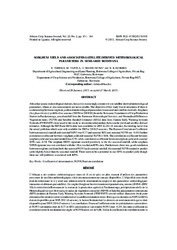| dc.contributor.author | Tsheko, Rejoice | |
| dc.contributor.author | Tapela, Mataba | |
| dc.contributor.author | Mashungwa, Gloria | |
| dc.contributor.author | Kayombo, Benedict | |
| dc.date.accessioned | 2024-11-14T12:56:37Z | |
| dc.date.available | 2024-11-14T12:56:37Z | |
| dc.date.issued | 2015-03-15 | |
| dc.identifier.citation | Tsheko, R., Tapela, M., Mashungwa, G., & Kayombo, B. (2015). Sorghum yield and associated satellite-derived meteorological parameters in semi-arid Botswana. African Crop Science Journal, 23(2), 151-164. | en_US |
| dc.identifier.issn | 2072-6589 | |
| dc.identifier.uri | https://hdl.handle.net/13049/768 | |
| dc.description | Journal article | en_US |
| dc.description.abstract | Africa has sparse meteorological stations, hence it is increasingly common to use satellite-derived meteorological parameters, where in-situ measuremnts are not available. The objective of this study was to determine if there is a relationship between sorghum yield and meteorological parameters (measured and satellite-derived). Sorghum (Sorghum bicolor) yield for five seasons (2005/6 to 2009/10) from the Botswana Department of Crop Production Station in Pandamatenga, actual rainfall from the Botswana Meteorologial Services, and Normalised Difference Vegetation Index (NDVI) and Satellite Rainfall Estimates (RFEs) data from Famine Early Warning Systems Network (FEWSNET) were used in this study to determine relationships between the yield and satellite derived estimates. Although the NDVI and RFEs data were available for 2005 to 2011 (6 seasons), the limiting factor was the actual yield data which were only available for 2005 to 2010 (5 seasons). The Pearson Correlations Coefficient between seasonal rainfall and seasonal NDVI was 0.77 and seasonal RFE and seasonal NDVI was -0.19. Further correlation coefficient between sorghum yield and seasonal NDVI is 0.88. The correlation coefficient between sorghum yield and seasonal rainfall was 0.53; while correlation coefficient between sorghum yield and seasonal RFEs was -0.38. The sorghum NDVI signature reacted positively to the the seasonal rainfall, while sorghum NDVI signature was not correlated with the 1 Km resolution RFEs data. Furthermore, there was good correlation between sorghum yield and both the seasonal NDVI and seasonal rainfall, the seasonal NDVI seemed to predict yield slightly better than the seasonal rainfall. There seem to be a potential to use RFEs to predict yield though there are still problems associated with RFEs. | en_US |
| dc.language.iso | en | en_US |
| dc.publisher | African Crop Science Journal | en_US |
| dc.relation.ispartofseries | African Crop Science Journal;Vol. 23(2), 151-164. | |
| dc.subject | Coefficient of determination | en_US |
| dc.subject | NDVI | en_US |
| dc.subject | Pearson correlation | en_US |
| dc.title | Sorghum yield and associated satellite-derived meteorological parameters in semi-arid Botswana | en_US |
| dc.type | Article | en_US |

